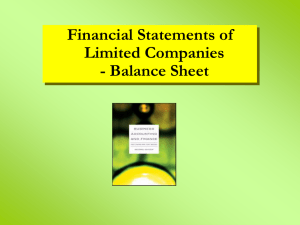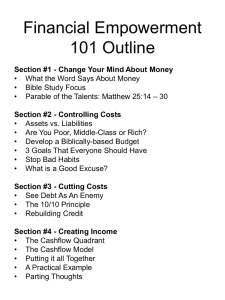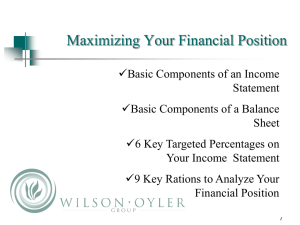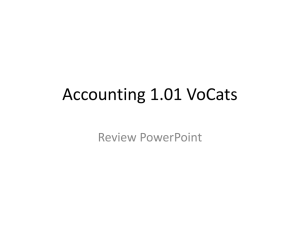Profit and Loss/Balance Sheets
advertisement
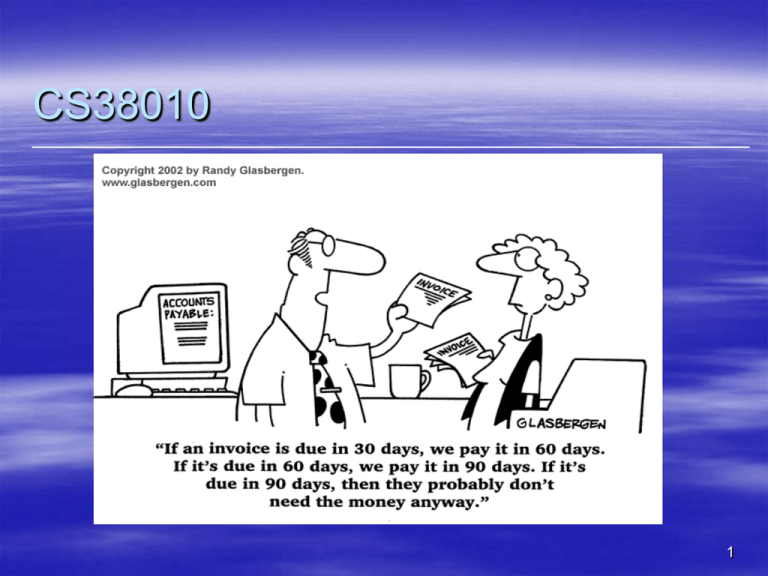
CS38010 1 P/L Costs Overheads Wages NI Rent Rates – Business & Water Gas & Electricity Telephone, ISP Postage, Printing, Stationary Advertising Insurance 2 P/L Costs …….. Repairs & Maintenance Interest Payments Bank Charges Depreciation Travel Legal Subscriptions and Periodicals 3 Sales And Income Invoice sales Cash Sales Interest on deposit 4 Cash In – Not Sales Equity Bank Loan/Mortgage VAT These DO NOT appear in profit/loss 5 Capital Equipment Capital Equipment does not appear in the P/L It is taken from the cashflow and the depreciation is treated as a cost in the P/L 6 Balance Sheet Snap Shot on a particular date How much are you worth? – Assets Fixed Asset Liquid (Current) Assets How much do you owe? – – – – – Tax VAT Creditors Bank Loans Shareholders 7 Balance Sheet Assets = Liabilities +Shareholders Equity 8 Start up Shareholders raise £50,000 Cash goes into bank Assets – Cash on hand £50,000 Liabilities + Sharehldrs – £0 +£50,000 9 Trading for a while Sales £10,000 (invoiced) Vat £1750 Purchases £2,000 Assets – – – – Receivables £11750 Cash on hand £48,000 Computers £2,000 Total £61,750 Liabilities & Sharehldrs – Profit £10,000 – Vat £1,750 – Shares £50,000 – Total £61,750 10 Balance Sheet Assets – Current Cash Accounts Receivable Inventory – Long Term Fixed or Tangible – Buildings, Furniture, Plant & Machinery Intangible – Name & Goodwill – Patents – Website 11 Balance Sheet Liabilities – Current Liabilities Accounts Payable Loan Payment Payable VAT Inland Revenue – Long Term Debt Remainder of Loan 12 Balance Sheet Shareholder Equity – Shareholdings – Retained profit 13 Equation Assets = Liabilities + Shareholders Equity Start of Business Sell shares for £50,000 on day Therefore balance sheet reads Assets = £50K Liabilities + £0 Shareholders Equity = £50K £50K = £0 + £50K P/L & Cashflow 1 Sales 10K Costs -8K Profit 2K Accum 2k 2 12K -9K 3K 5K 3 12K -9K 3K 8K 4 13k -10K 3K 11k 5 14K -10K 4K 15K 6 14K -10K 4K 19K Cash in 0K -8K 0K -9K 5K -9K 11K -10K 12K -10K 13K -10K -8K -17K -21K -20K -18K -15K Profit Cash Out Balance P/L & Cashflow now looks like 1 Sales 10K Costs -8K Profit 2K Accum 2k Profit Cash in Cash Out Cash on Hand £50K -£8K £42K 2 3 4 5 6 Balance sheet month end 1 Assets £10K in receivables £42K in the bank Liabilities Shareholders Equity = £50K Shares £2K profit £10K + £42K = £50K + £2K Purchases Month 2 During Month 2 we purchase £22K of hardware P/L & Cashflow 1 Sales 10K Costs -8K Profit 2K Accum 2k 2 12K -9K 3K 5K Cash in 50K -8K 0K -31K 42K 11K Profit Cash Out Cash on (9K costs and 22K equipment) Balance sheet Month 2 Assets Receivables = £22K Outstanding invoices Assets = £22k New equipment (no depreciation) Cash = £11K Liabilities £0 Shareholders equity Shares = £50K Profit = £5K Month 3 Money starts to come in Depreciation started P/L & Cashflow 1 2 3 Sales 10K 12K 12K Costs -8K -9K -9K Deprecat ion -1K Profit 2K 3K 2K Accum Profit 2k 5K 7K Cash in 50K 0K 5K Cash Out -8K -31K -9K Cash on 42K 11K 7K Balance Sheet Month 3 Assets Invoiced £34K, received £5K. Therefore: Receivables = £29K Assets = £21K Cash = £7K Liabilities £0 Shareholders Equity £50K Shares £7K Profit Balance Sheet (29+21+7)K = (50+7)K Receivab les Profit Assets Shares Cash Remember 1 Try this by purchasing items on credit to create liabilities – You put how much you owe on the liabilities side and the new item into your assets. – This balances. When you pay it off you lose the liability on one side and the cash from your asset side. Remember 2 Reduce the profit (shareholders equity) by the depreciation to date, balances with loss of same amount on the assets side of the equation. Balance sheets BALANCE. Balance sheets run vertically 28 Example 2 Shares = £50,000 Salaries = £8,000 per month Sales £15,000 per month Equipment = £12,500 Month 1 using cash Fixed Costs £4,000 1. Raise capital P/L Account: £0 Cashflow: £50,000 Balance Sheet: Assets = Liabilities + Shareholders Equity £50,000 = 0 +£50,000 2. Purchase equipment for £12,500 using cash P/L Account: £0 Cashflow: £37,500 Balance Sheet: Assets = Liabilities + Shareholders Equity £37,500 + £12,500 = 0 + £50,000 Cash Equipment 3. Sales Invoices sent Labour fees = £15,000 P/L Account: £15,000 Cashflow: £37,500 Balance Sheet: Assets = Liabilities + Shareholders Equity £37,500 + £12,500 + £15,000 Cash Equipment Invoices = £0 + (£50,000 + £15,000) Liabilities 4. Pay the wages and the fixed costs Salaries £8,000 Fixed costs £4,000 Total £12,000 P/L Account: Cashflow: £37,500 - £12,000 Balance Sheet: = £25,500 £15,000 - £12,000 = £3,000 Assets = Liabilities + Shareholders Equity £25,500 + £12,500 + £15,000 Cash Equipment Invoices = £0 + (£50,000 + £3,000) Liabilities 5 Month 2 receive all cash (unexpectantly) Cash in = £15,000 P/L Account: Cashflow: Balance Sheet: £25,500 + £15,000 =£40,500 £3,000 Assets = Liabilities + Shareholders Equity £25,500 + £12,500 + £15,000 Cash Equipment New cash = £0 + (£50,000 + £3,000) Liabilities 6. Purchase £16,500 of equipment on 30 days credit P/L Account: £3,000 Cashflow: Balance Sheet: £40,500 Assets = Liabilities + Shareholders Equity £40,500 + £12,500 + £16,500 Cash Equip + new equip now = £16,500 + (£50,000 + £3,000) Liabilities + Shareholders 7. Pay: P/L Account: Equipment bill £16,500 £3,000 last month Salaries £8,000 £3,000 this month Fixed £4,000 Invoice fees £15,000 Cashflow: £40,500 - £28,500 = £12,000 Balance Sheet: Assets = Liabilities + Shareholders Equity £12,000 + £29,000 + £15,000 Cash Equip Invoices = £0 + (£50,000 + £6,000) Liabilities + Shareholders




